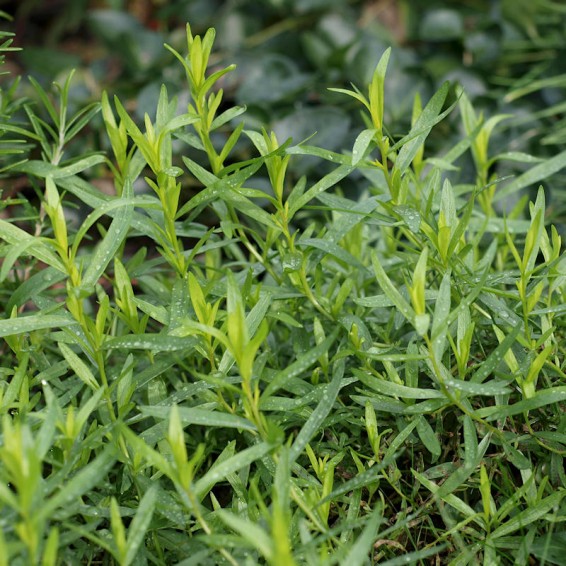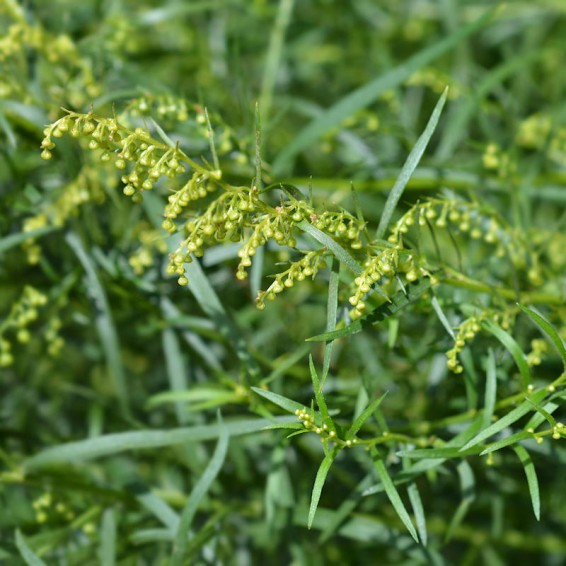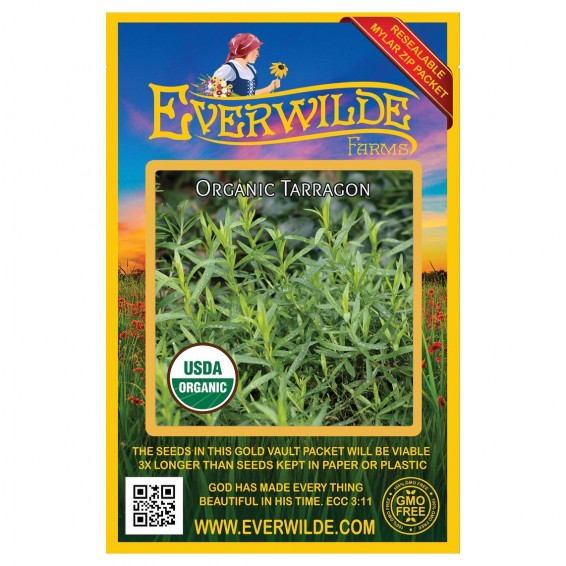Organic Tarragon Seeds
Artemisia dracunculus

- HOW TO GROW
- FAST FACTS
HOW TO GROW
Sowing: Start the seed indoors about a month before the last frost, thinly sowing on the surface of a flat; keep the temperature at 65-70 degrees F and away from direct sunlight until germination. When there is no chance of frost, transplant the seedlings 24-30" apart. Tarragon grows best in dry or well drained soil and full sun or light shade. Direct sowing is possible but somewhat difficult because of the extremely tiny seed. This herb attracts butterflies and bees, as well as repelling harmful insects and deer. Tarragon can be also grown from cuttings or root division, though growing it in a container is not recommended because of the size and sprawling growth habit of the plant.
Growing: Tarragon develops its full flavor when left to itself in dry soil and abundant sunlight. Mature plants tolerate drought very well, and should not be watered unless drought conditions persist. Overwatering can lead to root rot as well as other fungal diseases. For healthy growth, keep the plant trimmed.
Harvesting: Harvest fresh leaves as soon as the plant reaches a height of 6". The best time to harvest is in the morning after the dew has dried. Entire stems or the whole plant can also be cut slightly above ground level, since this will encourage new growth. To dry entire stems, cut them off and bundle them; hang them upside down in a dry, dark place for about 2 weeks. Strip the leaves from the stems and store them in a cool, dry place.
Seed Saving: The small green flowers should appear sometime in the fall, though the plant may not have time to produce seed if the growing season is too short. Harvest them individually as they begin to develop mature seed, which will look almost like black dust. Carefully gather the heads and spread them out to dry away from direct sunlight, then shake them lightly to remove the seed. Store the seed in a cool, dry place.
FAST FACTS
Latin Name: Artemisia dracunculus
Type: Open Pollinated, Heirloom, Warm Season
Life Cycle: Annual, Tender Perennial
USDA Zones: 5, 6, 7, 8, 9, 10, 11, 12
Seeds per Ounce: 200,000
Planting Method: From Transplant
Planting Depth: 0.1
Planting Spacing: 16
Days to Maturity: 365
Sunlight: Full Sun
Height: 30 Inches
Color: Green
Bloom Season: Blooms Early Summer, Blooms Late Summer
Uses: Aromatic
Diseases: Root Rot
DESCRIPTION
HOW TO GROW
Sowing: Start the seed indoors about a month before the last frost, thinly sowing on the surface of a flat; keep the temperature at 65-70 degrees F and away from direct sunlight until germination. When there is no chance of frost, transplant the seedlings 24-30" apart. Tarragon grows best in dry or well drained soil and full sun or light shade. Direct sowing is possible but somewhat difficult because of the extremely tiny seed. This herb attracts butterflies and bees, as well as repelling harmful insects and deer. Tarragon can be also grown from cuttings or root division, though growing it in a container is not recommended because of the size and sprawling growth habit of the plant.
Growing: Tarragon develops its full flavor when left to itself in dry soil and abundant sunlight. Mature plants tolerate drought very well, and should not be watered unless drought conditions persist. Overwatering can lead to root rot as well as other fungal diseases. For healthy growth, keep the plant trimmed.
Harvesting: Harvest fresh leaves as soon as the plant reaches a height of 6". The best time to harvest is in the morning after the dew has dried. Entire stems or the whole plant can also be cut slightly above ground level, since this will encourage new growth. To dry entire stems, cut them off and bundle them; hang them upside down in a dry, dark place for about 2 weeks. Strip the leaves from the stems and store them in a cool, dry place.
Seed Saving: The small green flowers should appear sometime in the fall, though the plant may not have time to produce seed if the growing season is too short. Harvest them individually as they begin to develop mature seed, which will look almost like black dust. Carefully gather the heads and spread them out to dry away from direct sunlight, then shake them lightly to remove the seed. Store the seed in a cool, dry place.
FAST FACTS
Latin Name: Artemisia dracunculus
Type: Open Pollinated, Heirloom, Warm Season
Life Cycle: Annual, Tender Perennial
USDA Zones: 5, 6, 7, 8, 9, 10, 11, 12
Seeds per Ounce: 200,000
Planting Method: From Transplant
Planting Depth: 0.1
Planting Spacing: 16
Days to Maturity: 365
Sunlight: Full Sun
Height: 30 Inches
Color: Green
Bloom Season: Blooms Early Summer, Blooms Late Summer
Uses: Aromatic
Diseases: Root Rot






